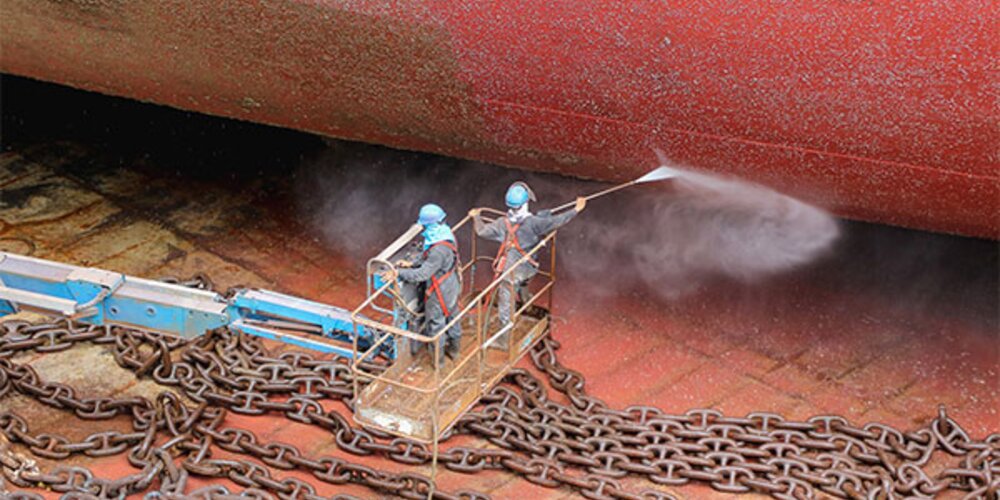Browse our services
Explore how Brookes Bell can help you
Find an expert
Meet our team, find and expert and connect
Contact us
Get in touch, we're here to help

Choosing an appropriate anti-fouling marine coating for a vessel’s hull is an important decision if owners, operators and charterers are to operate with minimised risk of potential financial repercussions. The complexity lies in getting the technical specification right, which involves considering the various factors of the vessel such as its type, speed, activity level, voyage history, and geographical route.
Marine biofouling is the accumulation of aquatic organisms on ships' hulls, which poses a significant threat to marine ecosystems and biodiversity by inadvertently transporting invasive species to new environments. Despite efforts to mitigate the issue, biofouling is an ongoing problem owing to increased global vessel traffic.
Aside from other biofouling management approaches, implementing tailored anti-fouling coatings and systems not only safeguards ecosystems but also enhances energy efficiency and reduces environmental footprints, aligning with global initiatives for sustainable shipping.
Each ship's unique characteristics influence its choice of coating. For instance, vessels traversing warm waters or regions prone to heavy fouling, like the Far East or Africa, require coatings with robust anti-fouling properties. Moreover, the speed of the vessel plays a crucial role, as faster ships, particularly in warmer waters, experience accelerated paint degradation due to hull polishing during movement.
Inadequate coating specifications can lead to quicker paint degradation, which can result in a greater chance of marine fouling attachment to exposed hull areas. This not only compromises the ship's efficiency but also increases maintenance costs and poses environmental risks.
Different types of coatings, such as silicone foul release coatings, offer tailored solutions for specific vessel types. While silicone paints excel on high-speed vessels, providing a non-stick surface that prevents fouling attachment, their effectiveness diminishes on slower ships like bulk carriers, or when undergoing slow steaming. Therefore, a more tailored approach is required to ensure a particular coating is the right choice for certain vessel profiles.
At its core are the financial risks associated with a vessel needing to be drydocked in order to be sufficiently cleaned and, in some instances, repaired.
“The financial impact of biofouling damage is manifold. From the need to consume more fuel to underwater inspections and cleaning, the potential need for early drydocking, and potential litigation due to breaches of Charterparty agreements, the financial repercussions for those that do not take their anti-fouling coatings seriously can escalate fast,” said Dr Marcelo Rodrigues, Senior Scientist at Brookes Bell.
“There is also demurrage if the vessel needs to be idle for a few days until cleaning is completed. If a bulk carrier costs around $20,000/day to hire and it stays idle for three days, then demurrage will cost $60,000 plus inspection and cleaning costs. Shipowners and charterers will often be subject to pay for those costs and that can lead to litigation,” he added.
Vessel Efficiency Gains
Effective biofouling management similarly enhances energy efficiency of vessels, for the simple reason of reducing hull resistance. The greater the build-up of fouling along a ship’s hull, the less efficient that vessel will be through increased resistance. With shipping players continuing to look for any marginal gain possible to improve vessel efficiency and meet decarbonisation targets, the correct anti-fouling coating is another important factor to consider.
Ensuring a smooth hull by reducing the fouling on hulls through the correct application of anti-fouling coatings can contribute to smoother sailing, ultimately resulting in greater energy efficiency. Operators and charterers can promote reduced fuel consumption which means both lower greenhouse gas (GHG) emissions and more cost-effective shipping operations.
“An effective anti-fouling coating will reduce the vessel's drag and, consequently, fuel consumption, as the build-up of marine life on the vessel’s hull will increase its surface roughness, which, in turn, increases frictional resistance and further fuel consumption,” said Dr Rodrigues.
“Studies have already shown that hull fouling build-up can increase fuel consumption by up to 40%. The more fuel consumption, the more greenhouse gas emissions are released,” he added.
Furthermore, evolving regulations on hull cleaning restrictions add another layer of complexity to coating selection.
“There are instances where certain countries will not allow vessels to dock in their ports. Take New Zealand for example, they are very strict on biofouling rules and biosecurity as this is a major pathway for the introduction of non-indigenous species into marine ecosystems. Every vessel that enters New Zealand is subject to governmental inspections prior to being allowed to enter their ports,” Marcelo noted.
Brookes Bell’s international coating scientists are able to respond to all manner of hull-related and biofouling issues, including underwater hull coating failures, vessel inspections and surveys, maintenance and repair coating recommendations, anti-fouling cleaning technology and regulatory affairs and expert witness testimony at arbitrations. With the complex and varied nature of anti-fouling methods, Brookes Bell’s expert scientific and technical consultancy services are the ideal partners to support shipowners’ hull servicing needs.